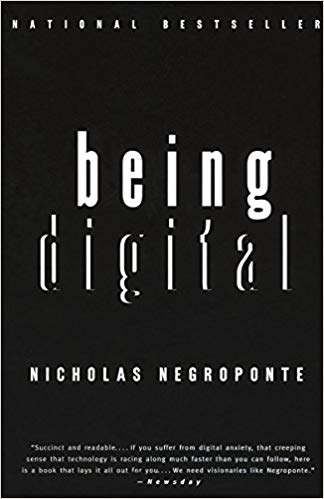
Being Digital by Nicholas Negroponte Twenty Three Years Later – It’s amazing how his vision at the time matches today’s reality. If you are looking for something cool to read, you won’t be disappointed with this classic that is still available online.
Introduction
- In 1995 Nicholas Negroponte, the founding director of the MIT Media Lab, published Being Digital. While reorganizing my library recently I picked it up and started reading it again. As I read I was amazed at how prescient his thinking was at the time. I felt that he had a very clear vision of where advances in computer technology and the Internet would take us. Much of what he predicted has come to pass while some of what he predicted has yet to happen. If he got anything wrong, I couldn’t find it to any significant degree.
Death of the Videocassette
- He saw the death of the videocassette and its associated rental businesses. He also saw services like Netflix coming due to the bandwidth of fiber and how it would be a game changer in terms of delivering content with copper serving as a stepping stone. He saw that advertising would be personalized as well. He also foresaw computers that would resemble thick pieces of paper like modern tablet computers.
- He was sad that most of the research directed at the advance of television was aimed at refining the display and increasing sizes as opposed to improving the artistry of content. He saw no reason not to expect 10,000 lines of resolution. He also predicted that computers and televisions would merge into a single device, which they have for many people as they are no longer dependent on the time of day when they want to watch something. He understood that using a lot of different fonts was a bad idea. In this case, less is more.
As For Schools
- He saw schools changing to become more like museums and playgrounds where children would assemble ideas and socialize with other children all over the world. While I’ve seen bits of this in some innovative schools, for the most part, we have a way to go to realize this vision.
- The Internet would create a totally new, global social fabric. With the Internet, schools could spend less time shoving facts into kids’ minds and more time engaging them in designing and building like they do in the maker spaces found in innovative schools. He decried the force-feeding of students’ left brains in schools that diminish the arts and other extracurriculars. Unfortunately, this has only gotten worse thanks to test-based reforms forced on schools by the federal government.
From Bits to Atoms
- He thought it was amusing that when ink is squeezed on to dead trees bits become atoms again. He saw the then-burgeoning field of multimedia as bridging the gap between science and art. He saw a day when most adults would also be computer literate. He predicted that virtual reality would allow you to put your arms around the Milky Way, swim in the human bloodstream, or visit Alice in Wonderland.
- He foresaw digital appliances with no edge at all like high-end cellphones and tablets. He saw that size would be driven by the size of pockets and watches. He said the wristwatch would migrate from a timepiece to a mobile command-and-control center as it has on my wrist thanks to my Apple Watch.
DrDougGreen.com If you like the summary, buy the book
Pages: 1 2





